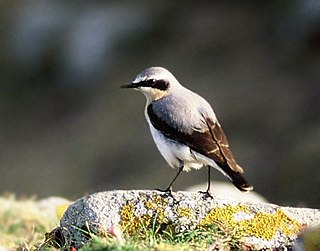
The wheatears are passerine birds of the genus Oenanthe. They were formerly considered to be members of the thrush family, Turdidae, but are now more commonly placed in the flycatcher family, Muscicapidae. This is an Old World group, but the northern wheatear has established a foothold in eastern Canada and Greenland and in western Canada and Alaska.

The rock thrushes, Monticola, are a genus of chats, medium-sized mostly insectivorous or omnivorous songbirds. All are Old World birds, and most are associated with mountainous regions.
The Serravallian is, in the geologic timescale, an age or a stage in the middle Miocene Epoch/Series, which spans the time between 13.82 Ma and 11.63 Ma. The Serravallian follows the Langhian and is followed by the Tortonian.

Nepenthes monticola is a tropical pitcher plant known from a number of mountains in the west central highlands of western New Guinea, where it grows at elevations of 1400–2620 m above sea level. Prior to its description as a species in 2011, N. monticola was lumped with the closely related N. lamii.
Carduelis parvulus is an extinct species of Carduelis that inhabited Hungary during the Neogene period.
Carduelis lambrechti is an extinct species of Carduelis that inhabited Hungary during the Neogene period.
Saxicola baranensis is an extinct species of Saxicola that inhabited Hungary during the Neogene period.
Calandrella gali is an extinct species of Calandrella that inhabited Hungary during the Neogene period.
Melanocorypha minor is an extinct species of Melanocorypha that inhabited Hungary during the Neogene period.
Luscinia denesi is an extinct species of Luscinia that inhabited Hungary during the Neogene period.
Lanius intermedius is an extinct species of Lanius that inhabited Hungary during the Neogene period.
Lullula minor is an extinct species of Lullula that inhabited Hungary during the Neogene period.
Riparia minor is an extinct species of Riparia that inhabited Hungary during the Neogene period.
Passer pannonicus is an extinct species of Passer that inhabited Hungary during the Neogene period.
Phylloscopus pliocaenicus is an extinct species of Phylloscopus that inhabited Hungary during the Neogene period.
Emberiza pannonica is an extinct species of Emberiza that inhabited Hungary during the Neogene period.
Emberiza parva is an extinct species of Emberiza that inhabited Hungary during the Neogene period.
Delichon polgardiensis is an extinct species of Delichon that inhabited Hungary during the Neogene period.
Cettia janossyi is an extinct species of Cettia that inhabited Hungary during the Neogene period.
Oenanthe pongraczi is an extinct species of Oenanthe that inhabited Hungary during the Neogene period.


